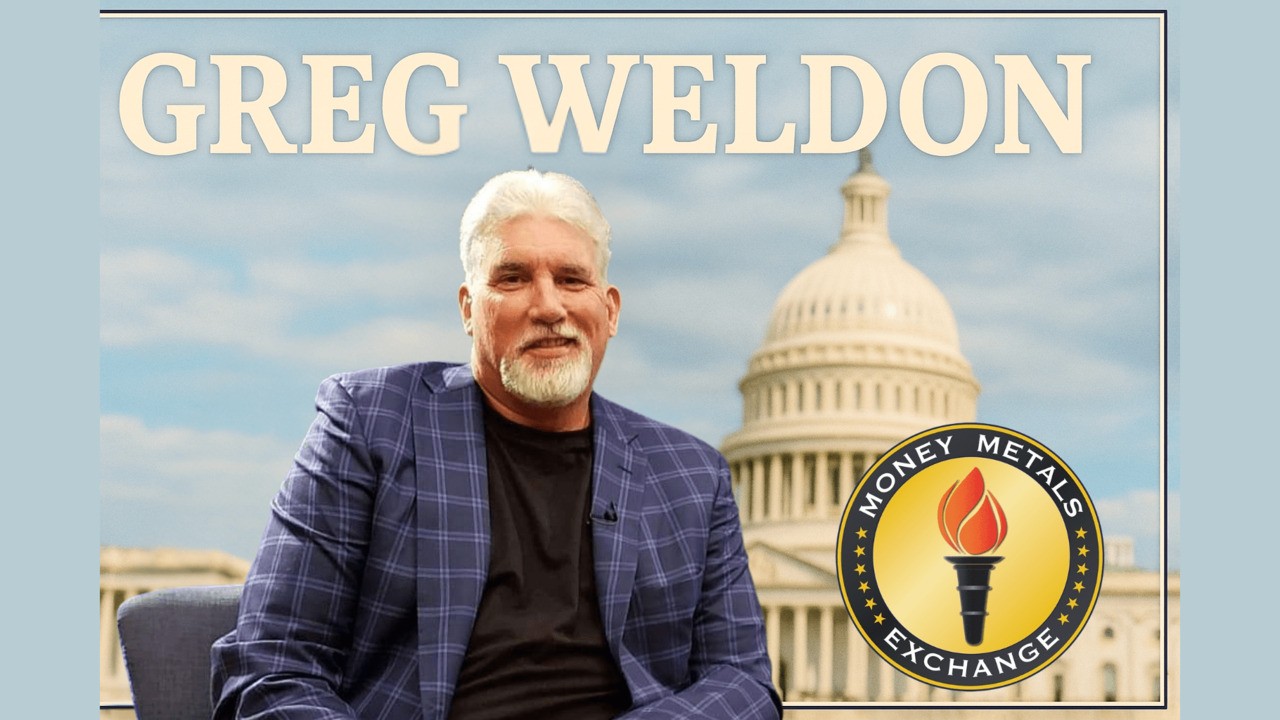(Money Metals News Service) On a recent episode of the Money Metals podcast, host Mike Maharrey interviewed Greg Weldon.
Gold had pushed past $4,300, and silver broke $54 on the day of recording. Asked if that’s bubble territory, Weldon said you can argue both sides, but futures open interest remains relatively low; the bid looks like accumulation, not a blow-off.
He tied the move to BRICS-aligned dollar selling and gold buying, repatriation of bars, tight vaults, and a U.S. dollar that hasn’t yet cracked.
Silver’s $36.50 breakout gave way to a sprint toward $50 and beyond, with $54 flashing intraday.
From there, the discussion widened to physical tightness, trust in the dollar, consumer and labor strains, a fragile equity market, and how a Fed pivot could propel the next metals leg.
If the Fed pivots back to easing and balance-sheet growth, Weldon expects the dollar to get hit, a setup that makes five-digit gold and silver’s march toward $100 plausible.
(Interview Starts Around 8:00 Mark)
About Greg Weldon

Gregory T. Weldon, also known as Greg Weldon, brings 42 years in markets, starting on the COMEX floor in the silver pit. He has been a floor trader, institutional futures broker, hedge-fund manager, and CTA (Series 3).
He publishes independent macro research at Weldon Online and co-hosts Free Money Markets & New Age Investing.
His managed-futures program, launched in 2018 around China’s crude-market shift and an inflationary monetary reset, carries a $1,000,000 minimum.
Recent reports—Debt Black Hole, Tom Cruise Market, and In Something Else We Trust—frame metals within de-dollarization, policy error risk, and physical tightness.
He emphasizes he’s not a perma-bull; he’ll be long or short as conditions warrant.
Drivers of the rally
Weldon points to BRICS-aligned buyers selling dollars, buying gold, and shipping metal home, draining vaults. That’s a physical driver, not a paper fling.
The dollar hasn’t even cracked; in several non-USD currencies, gold has already tripled or quadrupled, implying a U.S. dollar catch-up leg without speculative froth.
Positioning fits: futures open interest is “pretty dang low,” inconsistent with a classic bubble.
Silver’s breakout and tightness
Silver’s tape confirmed the turn. Weldon had circled $36.50 as the breakout; once through, the only question was speed to $50, not whether it would get there.
It reached $54 on the day of recording. He believes silver is on its way to $100, while warning that drawdowns can be sharp.
London looks tight. The widening disconnect between New York futures and London spot reads like real metal moving, not a basis quirk.
India’s shortage is so acute that firms recently sourced 1,000-ounce bars from Money Metals—supply stress in the wild.
Cross-border metal flows
The global back-and-forth of physical gold and silver is not a logistics footnote; Weldon calls it ominous.
He ties the oscillation of metal between hubs to eroding trust in state currencies and the dollar’s settlement role.
When counterparties prefer bars in domestic vaults over foreign ledger entries, the signal is systemic.
He can imagine trade relationships that insist on bullion settlement for certain flows.
Countries with deep reserves, like Italy, enjoy strategic latitude; former heavy sellers may find themselves short of monetary insurance.
Volatility and risk management
Volatility is now the feature. At $50 silver with $3 daily swings, a single futures contract can lurch roughly $15,000 in a day.
Even on $1,000,000-plus accounts, Weldon caps per-trade risk at about 0.5%–1%. With $50 silver and three-dollar intraday ranges, entries that respect those limits are hard to find.
In 42 years—starting in the silver pit—he hasn’t seen metals more volatile, more uncertain, or harder to handicap.
Respect the tape, but respect risk more.
The trust backdrop and U.S. debt
“In God we trust” doesn’t reconcile $36 trillion in federal debt, roughly $28 trillion of it held domestically.
Add households and Weldon pegs total debt near 185% of GDP. In several months of the last fiscal year, Washington spent twice what it took in.
He argues that decades of comforting narratives have masked a deficit path that erodes confidence and drives a global search for “something else” to trust.
Weaponized finance and de-dollarization
Policy has weaponized finance. Tariffs, sanctions, and asset seizures nudged counterparties off dollar rails just as China became the world’s dominant trader by volume.
Weldon says BRICS de-dollarization didn’t stop; it moved backstage and gained urgency, with buyers sourcing metal and moving it home.
As dollar settlement becomes leverage, incentives to diversify reserves and settlement grow. Gold buying and relocation are rational responses.
Stagflation signals and consumer strain
Fresh surveys flash stagflation. The Philly Fed and a Richmond–Atlanta Fed CFO survey show firms boosting capex to replace labor, not expand, even as consumers weaken.
Savings trail credit-card debt. Delinquency rates are the second highest since 2008–2009.
The consumer looks stretched and fragile to rate and price shocks.
The mix—labor substitution by firms and tapped-out households—implies slower growth with sticky prices, a metals-friendly setup.
Labor market deterioration
The 12-month rise in “not in the labor force” hit 3.219 million in July, a threshold that historically coincides with recessions.
Roughly 1.3 million people over 65 left the labor force. Immigration delivered about 2 million fewer entrants.
Weldon views these flows as structural and additive to the slowdown. A softening labor market layered onto a stretched consumer is how an equity correction can start.
Equities, Bitcoin, and the “Tom Cruise” market
Equities look precarious. Consumer-sensitive ETFs such as XLY and XRT won’t confirm S&P highs.
Weldon calls this the “Tom Cruise market”—Mission Impossible, hanging by a few fingers over a cliff.
A near-5% 30-year once shook stocks; now the market shrugs, which he sees as complacency amid tightening conditions.
Bitcoin has been equitized via ETFs and now correlates tightly with the S&P 500. He treats it as a leading indicator for risk appetite, a tell for when equities and, briefly, metals could wobble together.
Sentiment and banks’ forecasts
Banks are scrambling to lift gold targets after dismissing such levels not long ago. TV now normalizes $4,000 and $5,000 gold.
Weldon recalls a 2007 Squawk Box appearance predicting Fed debt monetization and $1,200 gold when the metal was near $400–$420. He was called a nut job—then it happened.
He also recounts a recent segment in which a novice-sounding pundit touted $4,000 gold, followed minutes later by a large client asking if it was time to liquidate miners.
For him, that’s a sentiment “tell” and a short-term risk flag.
Near-term downside and the 2008 template
If stocks crack, everything can get sold for a spell—metals included—before gold leads the rebound.
In 2008, gold fell about 25%, far less than equities, and snapped back first and hard.
He advises keeping powder dry for that moment while maintaining strategic exposure where risk tolerances allow.
Fed policy and the coming pivot
Weldon thinks the Fed is too timid. With the consumer, housing, labor—and maybe stocks—softening, staying restrictive risks a harsher, later pivot into rising inflation.
When cuts and balance-sheet expansion return, he expects the dollar to get whacked, the transmission channel for a renewed and possibly more powerful metals leg.
If the pivot arrives late, falling real rates will feel stimulative even if nominal policy stays “tight,” and metals tend to front-run that.
Five-digit gold scenario
Five-digit gold becomes conceivable if the dollar’s credibility erodes and financing needs force repeated devaluations. The magnitude, he stresses, is about the currency, not the commodity.
Nominal highs can mask real decline—Argentina’s MERVAL is his cautionary rhyme.
In that world, central-bank gold buying persists, and private investors treat bullion as savings rather than a trade.
Deglobalization, tariffs, and 2018’s turn
Deglobalization and tariffs cut both ways. On balance, Weldon says it’s bad for the largest debtor nation and relatively good for China, Russia, and OPEC, which gain leverage over pricing and flows.
He dates a key turn to 2018, when China launched crude futures benchmarked to OPEC grades with non-dollar pricing and Russian oil referenced to that lane—the beginning of the end of dollar monopoly in that slice of trade.
He argues this pivot seeded today’s bifurcated system—one where settlement options proliferate and bullion matters more.
Historical backdrop and paper shorts
He doesn’t dismiss the GATA-era context. The Washington Accord in 1999 ended official selling after the Swiss and Bank of England dumps and reset central-bank behavior.
Allegations of large paper shorts have lingered for decades. The present squeeze, he thinks, looks like those positions reconciling with physical reality.
For the first time in years, physical tightness—not just a narrative—is writing the plot.
What it means for investors
He is not a perma-bull. He’ll be long or short as conditions merit. At these prices and this volatility, new entries demand patience, strict sizing, and acceptance of wider ranges.
If stocks roll first, metals may offer the last great pullback before the next advance. Silver’s structural tightness and central-bank gold buying are secular forces worth aligning with.
Watch Bitcoin and consumer-sensitive equities for the first crack, then use that window to scale in.
Where to find Greg Weldon’s work
Read his research at Weldon Online, follow him on X @WeldonLive, and listen to the Free Money Markets & New Age Investing podcast on Buzzsprout and major platforms.
He offers a free trial to his research and manages money as a CTA; inquiries can be directed through Weldon Online.

